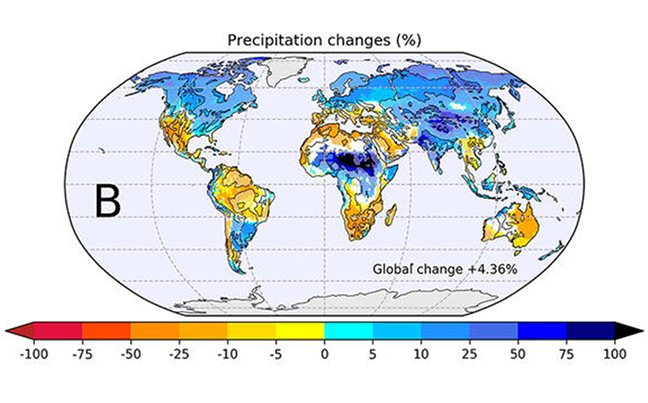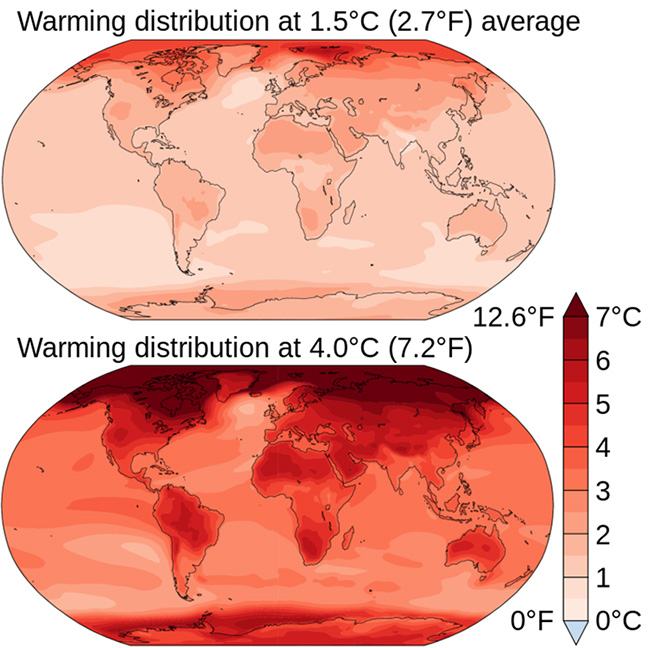Climate and energy
Louis Caudron
-

Available versions :
EN
Louis Caudron
Former deputy director at the French Ministry of Cooperation
In an effort to raise public awareness of the seriousness of the effects of climate change, the media generally associate global warming with increasing heatwaves and droughts, melting glaciers and rising sea levels. In reality, the effects of climate change are much more diverse, and they are not impacting all parts of the world in the same way. There are many losers, but there are also winners.
The first example concerns rainfall. Contrary to what some might think, global warming does not mean an increase in drought, but rather an increase in rainfall. The rise in temperature translates into an increase in evaporation both on land and at sea, leading to an increase in rainfall on a global scale. Overall, two-thirds of the world's population will see an increase in rainfall and one-third a decrease.
A map published by the CNRS illustration this development[1]

It shows the darker blue areas where rainfall is set to increase and the orange or yellow areas where it is set to decrease.
Places where rainfall is set to increase
Rainfall is set to increase in Canada, the northern United States, northern Europe, Russia (particularly Siberia), central Asia, India, northern China, central Africa and northern Argentina. These are areas where rainfall was already fairly abundant.
Places where drought is set to accentuate
The areas affected by more frequent droughts are all the countries around the Mediterranean Sea, South Africa, the southern United States (particularly California), Mexico, Brazil and Australia. With the exception of Brazil, these are areas that already had water deficits.
Access to drinking water
At present, two billion people worldwide, i.e. 25% of the planet, have no access to drinking water and around four billion, i.e. 50%, experience difficulties in obtaining water supplies at some time during the year. Most of these people live in areas where rainfall is set to decrease. Global warming will exacerbate the current difficulties and, to overcome them, it will be necessary to be imaginative both in terms of saving water and storing it during periods of surplus, so that it can be found and used during periods of deficit.
France is a case in point: the whole northern part of the country should experience an increase in rainfall, especially in winter, while the southern part will see a decrease especially in summer. The average rainfall across the country is 935 mm per year, but less than 600 mm in the Mediterranean area, compared with more than 2000 mm in the Cantal mountains and Chartreuse. In total, rainfall in France provides 503 billion m3 of water per year. Withdrawals from rivers and aquifers total 32 billion m3 per year. They break down as follows:
- Industrial water consumption: 8%.
- Agricultural abstractions: 9%.
- Waterway supply: 16
- Drinking water supply: 17
- Cooling of nuclear and thermal power stations: 50 %
Most of these abstractions use water for a particular purpose and then discharge it into the natural environment. If we look at the water actually consumed, the situation is different. Total consumption is 4.1 billion m3, broken down as follows:
- Agricultural extraction: 57
- Drinking water supply: 26
- Cooling of nuclear or thermal power plants: 12
- Industrial water extraction: 5
One cannot help but be struck by the discrepancy between the 503 billion m3 of rainwater that falls in France, the 32 billion m3 withdrawn and the 4.1 billion m3 actually consumed. This gives the impression that solutions could be found to reduce current and future tensions.
The situation in Europe
In the European Union, the European Environment Agency has just published its first report, which explains that Europe is the fastest-warming continent in the world, and that climate risks threaten its energy and food security, ecosystems, infrastructure, water resources, financial stability and the health of its inhabitants. According to the Agency's assessment, many of these risks have already reached critical levels and could become catastrophic without urgent and decisive action. This observation is shared by the Union’s Joint Research Centre.
Solutions for the future
The CNRS recommends that priority be given to retaining rainwater in the soil, rather than facilitating its drainage into the ocean. For years, riverbeds have been straightened and meanders removed to facilitate water run-off; hedgerows that formed natural barriers against run-off have also been torn up; farmland has been artificially drained to make it easier to cultivate. These practices must be abandoned and, on the contrary, obstacles to water run-off must be increased to facilitate infiltration. This means, for example, ploughing land along contour lines, creating earth or stone ridges along contour lines on sloping land, replanting hedges and, in general, recreating sponge areas.
Substitution reservoirs, which store excess water in winter for use in summer, can also be part of the solution. If they are fed by rivers in flood, they pose no problem. On the other hand, if they are fed by pumping into an underground water table, it is important to ensure that the withdrawal will not disrupt the functioning of the hydraulic system downstream.
The CNRS also points out that, for 9,000 years, mankind has developed effective techniques for capturing water and using it to grow crops. In the Mediterranean region, qanâts have for centuries been an effective system for capturing groundwater and then transporting it through underground galleries to the areas to be irrigated.
The south of France will experience a drier climate, not unlike that currently found in the Middle East and North Africa. Engineers would do well to study, with modesty, the techniques used in these countries to capture and make the best use of water resources.
Climate change is also increasing the frequency and violence of extreme weather events. This means that even in areas where droughts are set to increase, heavy rainfall could still cause catastrophic flooding.
Effects on maritime traffic
A less well-known consequence of climate change is the modification of major shipping routes.
At present, sea links between China and Europe are mainly via the Suez Canal or, in the event of the Suez Canal being blocked due to the current unrest in the Red Sea, via the Cape of Good Hope.
In the not-too-distant future, these links will be able to pass through the North-East Passage, which is now known as the Northern Sea Route, through the Bering Strait and along the Siberian coast. To date, this route is only accessible from July to October, i.e. a third of the year, under conditions set by Russia, i.e. ships must be accompanied by an icebreaker or have a reinforced bow.
By 2035, the Northern Sea Route could be ice-free all year round. The distance between Yokohama and Rotterdam on the Northern Sea Route is 7,000 km, compared with 11,000 km via the Suez Canal and over 14,000 km via the Cape of Good Hope. With its nuclear icebreakers and investments in Siberian ports, it is clear that Russia is preparing to facilitate passage along this route and to reap significant revenues from it, perhaps as significant as that enjoyed by Egypt from the Suez Canal.
The case of the Panama Canal
At the same time the Panama Canal is experiencing serious difficulties due to global warming. To cross it, boats have to pass through a system of locks that allow them to reach Lake Gatún, 27 metres above sea level. This is an artificial lake created by a dam on the Rio Chagres. However, in recent years, the reduction in the rainfall that feeds the Rio Chagres has forced those in charge of the canal to reduce the number of vessels authorised to cross it. The operation of the canal's huge locks consumes a lot of water and, in summer, the flow of the Rio Chagres is no longer sufficient to compensate for the water consumed by the locks. As global warming is set to exacerbate these difficulties, the Panamanian government is considering building a dam on another river, the Rio Indio, and taking the water to Lake Gatún through a tunnel. The project, which would cost at least $2 billion, is controversial and has not yet found any financing.
Faster change at the Poles
In general, climate change is much faster near the Poles than near the Equator. Russia, Canada and Greenland will benefit from this change. The maps below, taken from the IPCC's work, show the predicted temperature changes under two scenarios: limiting the global average temperature increase to 1.5°C or reaching 4°C.
As current trends take us much closer to the 4°C trajectory than to that of 1.5°C, it is clear that much of Siberia and northern Canada will experience a 6°C rise in average temperature.

It has been shown that Russia intends to increase its revenues by organising the passage of ships through its territorial waters. It will also be able to go much further in exploiting its territorial waters towards the North Pole. By 2035, the Russian Navy plans to have thirteen icebreakers, including nine nuclear icebreakers, allowing it to exploit most of its maritime domain.
Russia will also benefit from other advantages in Siberia: thanks to global warming, it will increase its arable land by tens of millions of hectares. In addition, areas of its territory that are currently frozen most of the year will be able to be explored for new resources (oil, gas or various minerals).
Canada and Greenland will experience the same positive development. The amount of land gained as a result of global warming is less than half of what Russia will reclaim from the vast Siberian landmass, but it will make a significant contribution. So, it is easy to see why Donald Trump has offered to buy Greenland from Denmark! As a matter of fact, Denmark Prime Minister, Mette Frederiksen, was, together with the President of the European Commission Ursula von der Leyen in Greenland on March 15 to reinforce Europe's concrete presence in Greenland and in the wider Arctic region.
[1] Most data come from n° 314 December 2023 of the CNRS’ Le Journal
Publishing Director : Pascale Joannin
On the same theme
To go further
Strategy, Security and Defence
Amiral (2S) Bernard Rogel
—
18 November 2025
Economic and Monetary Union
Patrice Cardot
—
10 November 2025
Economic and Monetary Union
Patrice Cardot
—
4 November 2025
Future and outlook
Salomé Zourabichvili
—
28 October 2025

The Letter
Schuman
European news of the week
Unique in its genre, with its 200,000 subscribers and its editions in 6 languages (French, English, German, Spanish, Polish and Ukrainian), it has brought to you, for 15 years, a summary of European news, more needed now than ever
Versions :



